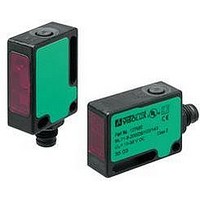MV71/59/102/115 PEPPERL & FUCHS, MV71/59/102/115 Datasheet - Page 11

MV71/59/102/115
Manufacturer Part Number
MV71/59/102/115
Description
Photoelectric Sensor
Manufacturer
PEPPERL & FUCHS
Datasheet
1.M776A115.pdf
(14 pages)
Specifications of MV71/59/102/115
Output Current
100mA
Sensor Output
NPN
Supply Voltage Range Dc
10V To 30V
Mounting Type
Horizontal
Switch Terminals
Cable
Load Current Rms Max
100mA
Supply Voltage Min
10VDC
Operating Temperature Max
-4°F
Lead Free Status / RoHS Status
Lead free / RoHS Compliant
ML7 Series Sensitivity Adjustment
ML7 photoelectric sensors are available with three different
configurations for sensitivity adjustment. The first type
is for the ML7-8-H background suppression models, the
second is for the ML7-54-G retro-reflective mode for clear
object detection, and the third is for all other ML7 types.
ML7-8-H (Background Suppression Mode)
Adjustment
The adjustment for the ML7-8-H models includes a single
potentiometer for sensitivity adjustment. The multi-turn
potentiometer can be turned toward the larger end of the
marked swirl to increase the sensing range or toward the
shorter end of the swirl to decrease the sensing range.
Light on / dark on mode is determined by the wiring.
ML7-54-G (Retro-reflective Mode for Clear
Object) Adjustment
The adjustment for the ML7-54-G also includes one
potentiometer, but with five settings: N, T, I, II, and III. Light
on / dark on mode is determined by the wiring.
To program:
1. Align the powered ML7-54-G to its reflector with the
2. Turn the potentiometer from N to T and wait
3. Turn the potentiometer to either I, II, or III depending
The green LED will turn off then on again for less than a
second to signify when the potentiometer position has
been changed. The potentiometer can be turned in either
direction, and its pointer must be within the printed arc of
the desired setting.
After a successful teach, settings will be stored even if
power to the sensor is disconnected. Detection of low-
contrast transparent objects is affected by excessive lens
contamination.
Subject to modifications without notice
Pepperl+Fuchs Group
www.pepperl-fuchs.com
potentiometer in its default setting at "N". Both the
green and yellow LEDs should be on solid which
indicates that the sensor sees the reflector with
sufficient excess gain. If the green LED is on and the
yellow LED flashes (4Hz), then the reflector is not seen
with enough excess gain and should be re-aligned and/
or moved closer. The sensor can detect opaque targets
in this normal mode.
approximately 2 seconds until the yellow and green
LEDs flash (2.5 Hz).
on the contrast desired. (Refer to "Modes Selected by
Potentiometer" chart.)
Configuration 1
(ML7-8-H)
Photoelectric Sensors
fa-info@us.pepperl-fuchs.com
Configuration 2
USA: +1 330 486 0001
(ML7-54-G)
(ML7(1)-8-200, ML7(1)-55,
ML7(1)-6, MV7(1))
Configuration 3
fa-info@de.pepperl-fuchs.com
Germany: +49 621 776 0
LED Diagnostics
Green LED
ON solid
Flashing (0.8Hz)
Flashing (4Hz)
Flashing (2.5Hz)
Flashing (8Hz)
ON solid
ON solid
Modes Selected by Potentiometer
Position
N
T
I
II
III
ML7(1)-8-200, ML7(1)-55, ML7(1)-6, and MV7(1)
Adjustment
1. With the sensor connected to the specified supply
2. Press the teach button once. The green LED will turn off
3. Press and hold the teach button until the green and
voltage, aim the sensor’s light beam at the target for
diffuse mode, at the reflector for retro-reflective mode,
or align the transmitter and receiver for thru-beam
mode.
and on again to acknowledge this step.
yellow LEDs blink simultaneously (2 Hz frequency).
The green and yellow LEDs will then blink alternately (2
Hz frequency) to indicate an internal set-up procedure.
If the teach is successful, both the green and yellow
LEDs should be on continuously. The green LED
indicates power is supplied to the sensor, and the
yellow LED indicates if light is received.
If the teach is not successful, then both the green and
yellow LEDs blink alternately at a faster rate (4 Hz
frequency) for about 5 seconds and the sensor will
return to its maximum sensitivity default setting. In this
case, steps 1 through 3 should be repeated.
The default setting for this series is maximum
sensitivity. If resetting the sensitivity to default is
desired, repeat steps 1 through 3 but with no target,
reflector, or thru-beam alignment.
fa-info@sg.pepperl-fuchs.com
Singapore: +65 6779 9091
Copyright Pepperl+Fuchs
Mode
Normal mode – for detection of opaque objects
Teach mode
10% contrast (most transparent targets, such as clear
PET bottles with water)
18% contrast (clear glass bottles)
40% contrast (least transparent, or more opaque,
targets, such as colored glass)
Yellow LED
—
OFF
OFF
Flashing (2.5Hz)
Flashing (8Hz)
Flashing (4Hz)
ON solid
Indicates
Power ON
Under-voltage
Short-circuited output
Teach mode initiated
Teach not successful
Marginal excess gain
Light is received
473












